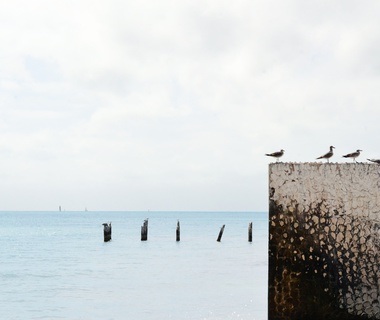A conversation on perspectives
Talking and sharing ideas from across the sea to the suburbs of Canada
Through this conversation between my dear friend and myself, I will also share pictures from a styling shoot with François and pictures from Fashion week.
F : My name is François Picard, I am 24 years old. I was born in Montreal, Canada and now I live in Paris, France. It’s been a year and half since I left my home. I work for Maison Margiela, a french fashion house I would say, established in France but originally from Belgium.
S : Why Fashion ?
F : Well, I have a lot of interests: fashion, music, in a way art itself and design. My passion for fashion came gradually. At first, it was something I observed objectively. It was mostly the clothing or more precisely the final product that interested me. Eventually, when I realized clothing would most likely have a reference or even relate to a certain event in time or a piece of art like paintings, I started to observe clothing like a work of art on its own which speaks its very own language and emotions. More and more, fashion has a more personal connection with me; it makes me feel more attached to it which is also how it became, most likely, a bigger passion. I would certainly say I would love to live by fashion.
S : What pushed you to leave Montreal to discover the fashion scene in Antwerp and Paris?
F : For a long time I was working in fashion in Montreal. It all started as a skateshop and then escalated level by level to end up in high end and Haute Couture retail. I think for me it was the peak of what I could achieve and see here in Montreal. Without saying there is nothing in Montreal but more likely that I wanted to learn more. I wanted to refine my experience and sharpen my knowledge. It’s at the moment that you and I had the opportunity to come to Paris for the Fashion Week. I think that was what triggered me to leave because I was thinking this through and I thought that if I’m leaving for Europe, I will not come back, well not directly after Fashion Week. This is how I led my journey by going to Antwerp. Mostly by interest for the Belgium’s Designer and then eventually it led me back to Paris. The main issue with Antwerp was the language barrier since I don’t speak Flemish compared to Paris where I could easily speak French or English.
Although I was very lucky, as soon as I arrived I had a contract with Acne Studio, afterwards the opportunity to work with Maison Margiela presented itself. For me, it wasn’t even a question, I signed the contract. Here I am now. It is something that happened by coincidence per say. For as long as I could remember I always wanted to do this. I always thought the experience you could acquire in Montreal was limited especially if you want to work alongside major creators or in big Houses, so I thought the only solution was to fly to Europe or the USA where there is a bigger market. Even Asia was tempting but Europe was the most accessible. Other than the ease of speaking the language, there was also the fact of being more familiar with the creators based here. I always had a bigger interest in European designers than American. My knowledge helped me a lot to back up my decision to come to Europe so I could focus on the creators from here, not necessarily from Paris but from all over France.
S : Do you have a piece right now in your wishlists or pop in your mind that would be the holy grail, a must needed and why?
F : I'm trying to think… a piece in particular I would really like to have in my possession would be any piece from Kiko Kostadinov and Stüssy. An exclusive item of Dover Street Market. Whether it be the hoodie, t-shirt, pants or even the bucket hat. I think it would be a piece I would really love having in my wardrobe because it was in the first piece that Kiko Kostadinov released internationally which sold at Dover Street Market New York.
S : It was very limited if I recall.
F : Yes, it was super limited there was a very low amount of each piece and it was its first collaboration as a whole sold to the public. Most of the time people keep those items otherwise the price is outrageous. But honestly, if I see one, in my size that would pop on Grailed, I would probably make an offer because it’s an important piece in the history of this creator.
I found it very impressive that for its first collection right after graduating from Central Saint-Martin, it is a collaboration with Stüssy sold at Dover Street Market. For most creators, this achievement in a career really defines your potential in a way and it is something that most creators would love to happen. What about you? Any piece?
S : Well when I think of it, my poncho would be a piece I’ve wanted for so long in my wardrobe. I always wanted one, it’ll sound dumb but it’s because of all the manga I read and the anime I watched. Each time I was seeing a character wearing one, I was just shocked how awesome it looks. As simple the design is, I feel that it is really hard to find one unique. My first poncho was a The North Face which I bought 4 years ago in Japan. It was practical, it still is but it is not as wearable. I use it when it’s rainy. It was by coincidence that I found the one on Kapital. But the more I read about the brand, the more I was able to see the inspiration into the piece but also what I personally like.
F : So you bite the bullet
S : Definitely, I was thinking about it for 2 weeks. Thinking about the fits and how I would wear it.
F : Compare to your The North Face one I feel that this one really gives you something more unique.
S : Exactly and the one I bought from The North Face was such a funny story too. Me and my friend were walking towards the The North Face store in Tokyo speaking about poncho. At the moment we arrived in front of the store there was one displayed in the window. Like if it was a sign.
F : I think it is very interesting to approach and to hear about how your style ended up, how it is now, how it started. Like us, we used to wear more of a skateboard style. But I think those interests don’t just go away but they transit to a new level till you reach your true self.
S : Fashion has become more and more ephemeral. Trends pass by and change constantly. How would you advise someone who wants to build their wardrobe?
F : I think you would probably agree on this. We always say to not buy a bigger piece but instead to go with something timeless. Well this was really the mentality I had when I left. Now, I realized that if you’re buying a big item it must have this timeless aspect. Something that’ll pass through trends and time. So it’s mostly about investing in garments that would be ageless even though it’s kind of hard to say. I think when you invest in a bigger piece, building your wardrobe around this clothing is much easier than buying a lot of basics and trying to blend bigger garments afterwards. Like for you when you bought that Kapital poncho. I think it is easier to match your wardrobe around that piece than buying a ton of basics and then end up with a Kapital poncho.
S : I think you are totally right. The way we used to build our wardrobe when we were working at Empire was basically what you said. We bought so many basics and when it came to buying a much more bold item, we weren’t ready to commit per say or even scared to buy it. We had so much clothing that buying another one was too much. We were surely not able to match those pieces because of what we already had. While now we completely switched our mindset. We dare to invest in bold garments cause we know basics will always stay basics. Finding one is much easier than finding a timeless piece.
F : Well of course. The thing is most people tend to shop with their emotions. Impulsive buying is potentially something you’ll regret. When it comes to building your wardrobe I think the best thing to do is to step back and think about it for a while. A few days or even weeks.
You need to imagine yourself with it. Speaking for myself I almost dream about it, imagine outfits and how I would wear it. I go with this process for only one piece when before I was constantly buying with emotions. Thinking this through helps me a lot to be sure the clothing is unique, do I have something similar, will it match with what I have or I have to buy a whole outfit just to wear it.
S : For the both of us, we had this situation where the client comes in with this request of finding him a whole outfit just because he bought one specific item. Doing this kind of buying lacks reasoning and it’s always by impulse. It also implies that you have to enlarge your wardrobe instead of bringing bigger garments that match already with the other unique garments you have. It brings a new perspective.
F : You add more value to it basically. It’s a simple metaphor but it’s like building a house. No matter how you do it you need to start with base. For a lot of us this period is where we decide what’s our style and how we want to express ourself. Especially when you work in fashion, photography and even in the world of music. Your outfit doesn’t define you but it expresses who you are cause you choose what you like and what represents you. It tells a story about yourself. From where I stand, I stayed a long time figuring out what would be my « base ». When I finally start to find myself, understand my needs and knowing the work environment I’ll be working and live in, I kind of knew how to fulfill it and start building around my base.
S : By living in a different country and traveling around Europe. Do you think the perspective of fashion in Europe is somehow different from the one in North America?
F : I think so. Well it is hard to say because in Montreal I didn’t know a lot of people who were in fashion except the ones I worked with. But of course,the perspective here in Paris is different because it is an international city known for fashion. There are Fashion Weeks, some creators live here, some Fashion Houses are originally from here. I would say that the environment here is definitely more fashionable but also more suitable for fashion per say. Mentally, I think everywhere you are there are always different types of persons. In a certain way, I think you can say as much when you were in Japan… You have some people who stay on the surface, some who are a little bit more interested and you have those who are really interested about it. You also have those who we would call fashion heritage. In a way it’s those people who wear the same designers for decades. I think those types of people are everywhere but the only difference is depending where you are the proportion of each type will change. By having more Fashion Houses and creators here it goes without saying that the interest will be bigger. Furthermore, in Paris it’s almost every day you see a fashion event. Being in Paris, I think here people are more conscious of how they dress themselves, not generally but they are fashionable per say, not necessarily trendy but “à la mode”.
S : Would you say that stores have an impact on how the vision of fashion is received by cities? If I precise on Montreal per say cause if we choose New York we all know there’s more stores and a lot of good places to shop. But also people are more conscious of trends and designers.
F : I think so. For instance, there aren’t a lot of consignment stores here ; if you go to Les Galeries Lafayette, there’s 14 floors. It’s too scattered compared to The Broken Arm where the selection is really curated. You saw it too. In Montreal I don’t think there are a lot of options in between those two.
It’s either one store where everything is there or a small store with a really narrow selection. You don’t have a store like The Broken Arm in Montreal. A store that comes with a universe.
S : When you think about it, we don’t have stores like Dover Street Market in Montreal. Of course their selection is more precise but you can see the store as a museum to introduce you to fashion in a unique way. Like when we went to The Broken Arm, I think what we loved the most was how the selection brought a unique ambiance. Their selection was really rich in terms of colours, models and how they displayed each item.
F : Yes but besides the selections. If we’re speaking about the stores we just said. Their selection is limited but you don’t come shop there only for the style they offer but mostly for the universe they’re bringing alive. Furthermore their customer service and musical atmosphere. In other words you shop in something out of range of classic retail experience. This is what I think Montreal lacks. It lacks stores where you go to live an experience and learn. It’s more bold to start a store like that but I think those kinds of stores that can offer a new perspective of fashion to their clientele can elevate how we see fashion as a whole.
S : Would you say that with your 1 year at Maison Margiela inspired you for your drawing, projects or even your own outfit in some way?
F : Not everything was necessarily affected by Margiela but I would say yes. I think Margiela has brought a standard for me. When I look into it now my standards are here so my question is what can I do to equalize this or surpass it. To accomplish that I think it is very important to remain critical. Personally, the quality of production at Margiela is superior in some way. What really impresses me is all their process made by hand like Tabis per say. Even their Bianchetto process ; everything that is painted by hand with white painting. Taking the time to watch every stitching, analyze the garments, how they build it, is something that inspires me. I feel that the way they’re doing it is a standard for what I would like to make in the future.
S : By being in direct contact with most of every garment, did it help you to understand better how to look into each collection?
F : Well I think it piled up to a point that I can identify clothing to another one in time. Being able to see the references, what probably inspired to do the collection. It’s something really nice to be able to see the interconnection of each collection with another one just because you saw an image in a specific time. At the end, what’s important is to always see a new reference and highlight it in your head so you can use it anytime. It helps you a lot to imagine better the references all creators use for their collection. Like Galliano for instance, Creative Director for Maison Margiela at the moment. He creates a whole universe around his collection. To be able to detect colours and themes he uses with all the images you stored in your head is something so much more interesting especially in fashion where reference is everywhere.
S : It is interesting and I think with all the references you are storing and the experience you’re gaining from working in Paris you’ll be able to create something really unique in a near future.
“Fashion is a field where everything can be interconnect.” - F











